Financial Decision Making Report for Panini Ltd
VerifiedAdded on 2023/06/11
|10
|3235
|357
AI Summary
This report explains about the duties and responsibilities of the accounting and finance of Panini Ltd. Various ratios are calculated in order to determine the performance of the business organisation.
Contribute Materials
Your contribution can guide someone’s learning journey. Share your
documents today.

BM 414 Financial
Decision Making
Report
Decision Making
Report
Secure Best Marks with AI Grader
Need help grading? Try our AI Grader for instant feedback on your assignments.
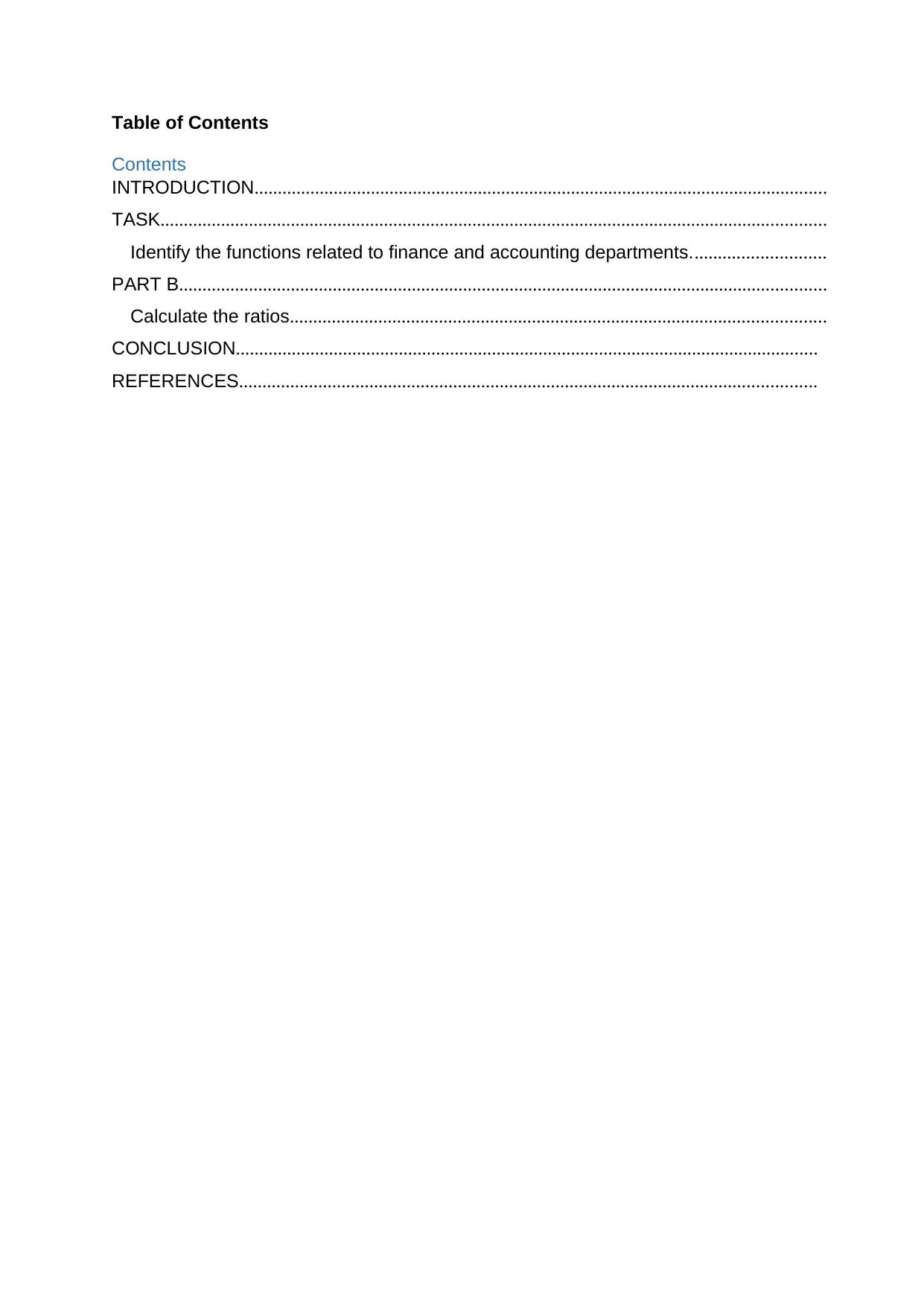
Table of Contents
Contents
INTRODUCTION...........................................................................................................................
TASK...............................................................................................................................................
Identify the functions related to finance and accounting departments.............................
PART B...........................................................................................................................................
Calculate the ratios...................................................................................................................
CONCLUSION.............................................................................................................................
REFERENCES............................................................................................................................
Contents
INTRODUCTION...........................................................................................................................
TASK...............................................................................................................................................
Identify the functions related to finance and accounting departments.............................
PART B...........................................................................................................................................
Calculate the ratios...................................................................................................................
CONCLUSION.............................................................................................................................
REFERENCES............................................................................................................................
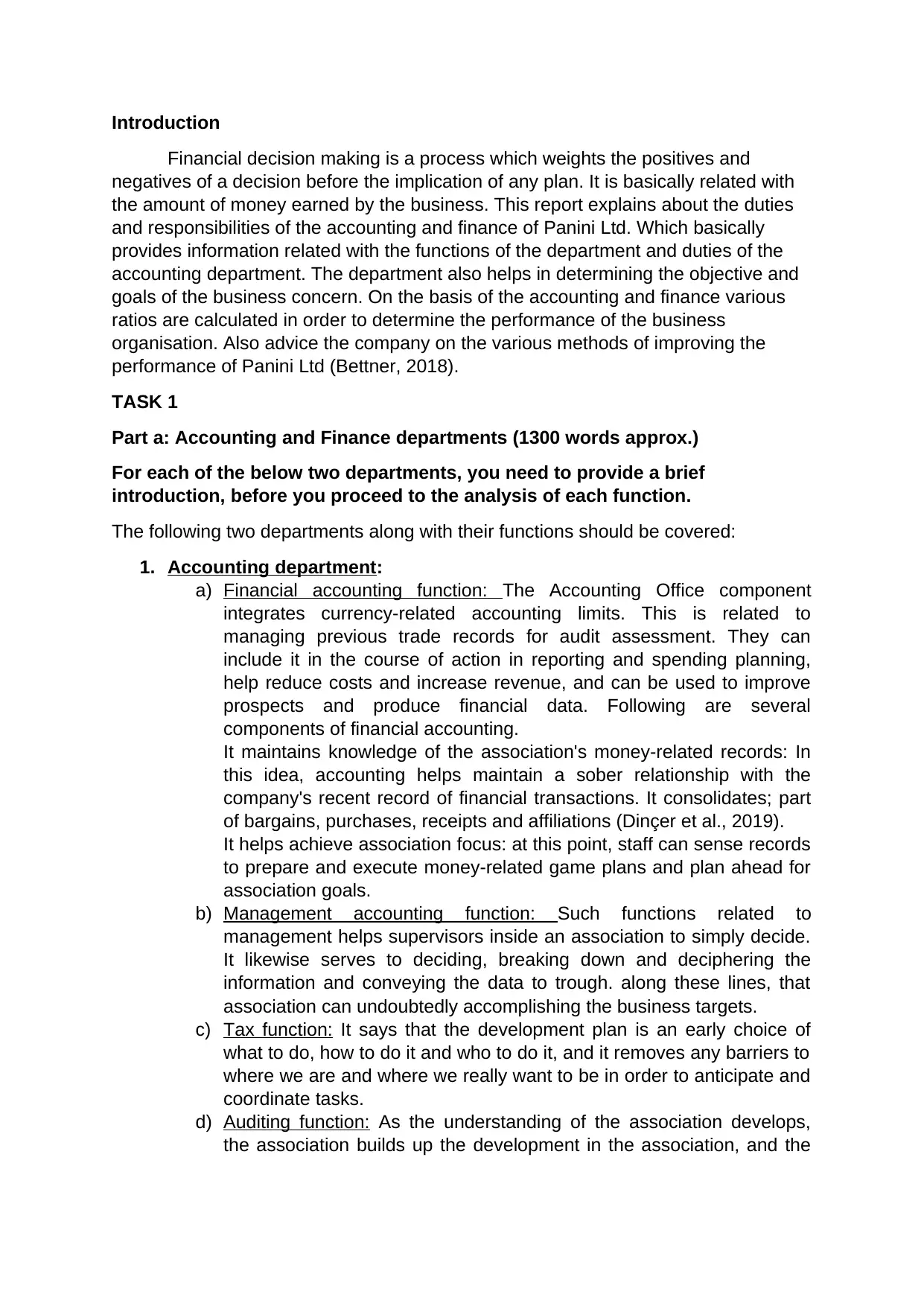
Introduction
Financial decision making is a process which weights the positives and
negatives of a decision before the implication of any plan. It is basically related with
the amount of money earned by the business. This report explains about the duties
and responsibilities of the accounting and finance of Panini Ltd. Which basically
provides information related with the functions of the department and duties of the
accounting department. The department also helps in determining the objective and
goals of the business concern. On the basis of the accounting and finance various
ratios are calculated in order to determine the performance of the business
organisation. Also advice the company on the various methods of improving the
performance of Panini Ltd (Bettner, 2018).
TASK 1
Part a: Accounting and Finance departments (1300 words approx.)
For each of the below two departments, you need to provide a brief
introduction, before you proceed to the analysis of each function.
The following two departments along with their functions should be covered:
1. Accounting department:
a) Financial accounting function: The Accounting Office component
integrates currency-related accounting limits. This is related to
managing previous trade records for audit assessment. They can
include it in the course of action in reporting and spending planning,
help reduce costs and increase revenue, and can be used to improve
prospects and produce financial data. Following are several
components of financial accounting.
It maintains knowledge of the association's money-related records: In
this idea, accounting helps maintain a sober relationship with the
company's recent record of financial transactions. It consolidates; part
of bargains, purchases, receipts and affiliations (Dinçer et al., 2019).
It helps achieve association focus: at this point, staff can sense records
to prepare and execute money-related game plans and plan ahead for
association goals.
b) Management accounting function: Such functions related to
management helps supervisors inside an association to simply decide.
It likewise serves to deciding, breaking down and deciphering the
information and conveying the data to trough. along these lines, that
association can undoubtedly accomplishing the business targets.
c) Tax function: It says that the development plan is an early choice of
what to do, how to do it and who to do it, and it removes any barriers to
where we are and where we really want to be in order to anticipate and
coordinate tasks.
d) Auditing function: As the understanding of the association develops,
the association builds up the development in the association, and the
Financial decision making is a process which weights the positives and
negatives of a decision before the implication of any plan. It is basically related with
the amount of money earned by the business. This report explains about the duties
and responsibilities of the accounting and finance of Panini Ltd. Which basically
provides information related with the functions of the department and duties of the
accounting department. The department also helps in determining the objective and
goals of the business concern. On the basis of the accounting and finance various
ratios are calculated in order to determine the performance of the business
organisation. Also advice the company on the various methods of improving the
performance of Panini Ltd (Bettner, 2018).
TASK 1
Part a: Accounting and Finance departments (1300 words approx.)
For each of the below two departments, you need to provide a brief
introduction, before you proceed to the analysis of each function.
The following two departments along with their functions should be covered:
1. Accounting department:
a) Financial accounting function: The Accounting Office component
integrates currency-related accounting limits. This is related to
managing previous trade records for audit assessment. They can
include it in the course of action in reporting and spending planning,
help reduce costs and increase revenue, and can be used to improve
prospects and produce financial data. Following are several
components of financial accounting.
It maintains knowledge of the association's money-related records: In
this idea, accounting helps maintain a sober relationship with the
company's recent record of financial transactions. It consolidates; part
of bargains, purchases, receipts and affiliations (Dinçer et al., 2019).
It helps achieve association focus: at this point, staff can sense records
to prepare and execute money-related game plans and plan ahead for
association goals.
b) Management accounting function: Such functions related to
management helps supervisors inside an association to simply decide.
It likewise serves to deciding, breaking down and deciphering the
information and conveying the data to trough. along these lines, that
association can undoubtedly accomplishing the business targets.
c) Tax function: It says that the development plan is an early choice of
what to do, how to do it and who to do it, and it removes any barriers to
where we are and where we really want to be in order to anticipate and
coordinate tasks.
d) Auditing function: As the understanding of the association develops,
the association builds up the development in the association, and the
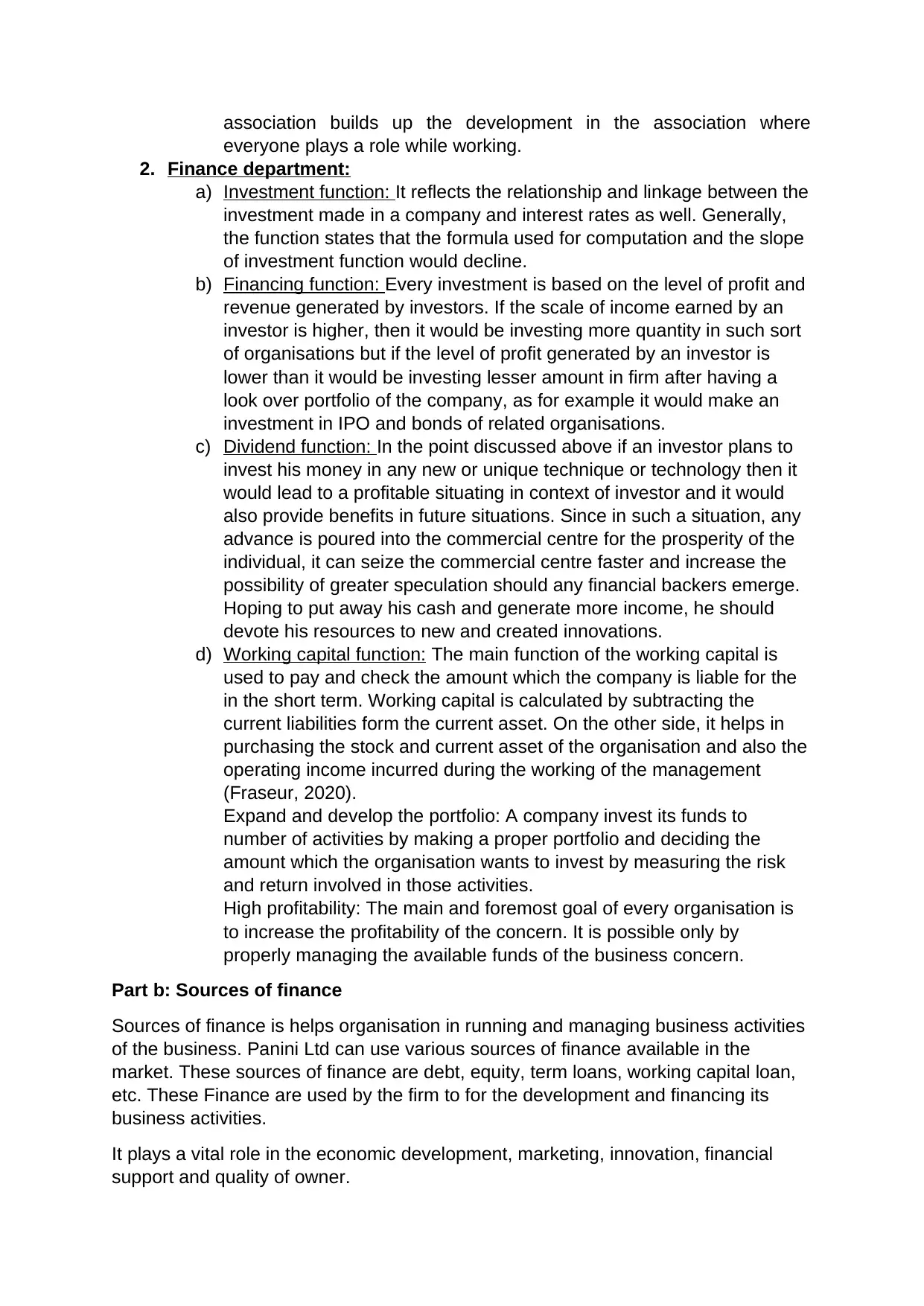
association builds up the development in the association where
everyone plays a role while working.
2. Finance department:
a) Investment function: It reflects the relationship and linkage between the
investment made in a company and interest rates as well. Generally,
the function states that the formula used for computation and the slope
of investment function would decline.
b) Financing function: Every investment is based on the level of profit and
revenue generated by investors. If the scale of income earned by an
investor is higher, then it would be investing more quantity in such sort
of organisations but if the level of profit generated by an investor is
lower than it would be investing lesser amount in firm after having a
look over portfolio of the company, as for example it would make an
investment in IPO and bonds of related organisations.
c) Dividend function: In the point discussed above if an investor plans to
invest his money in any new or unique technique or technology then it
would lead to a profitable situating in context of investor and it would
also provide benefits in future situations. Since in such a situation, any
advance is poured into the commercial centre for the prosperity of the
individual, it can seize the commercial centre faster and increase the
possibility of greater speculation should any financial backers emerge.
Hoping to put away his cash and generate more income, he should
devote his resources to new and created innovations.
d) Working capital function: The main function of the working capital is
used to pay and check the amount which the company is liable for the
in the short term. Working capital is calculated by subtracting the
current liabilities form the current asset. On the other side, it helps in
purchasing the stock and current asset of the organisation and also the
operating income incurred during the working of the management
(Fraseur, 2020).
Expand and develop the portfolio: A company invest its funds to
number of activities by making a proper portfolio and deciding the
amount which the organisation wants to invest by measuring the risk
and return involved in those activities.
High profitability: The main and foremost goal of every organisation is
to increase the profitability of the concern. It is possible only by
properly managing the available funds of the business concern.
Part b: Sources of finance
Sources of finance is helps organisation in running and managing business activities
of the business. Panini Ltd can use various sources of finance available in the
market. These sources of finance are debt, equity, term loans, working capital loan,
etc. These Finance are used by the firm to for the development and financing its
business activities.
It plays a vital role in the economic development, marketing, innovation, financial
support and quality of owner.
everyone plays a role while working.
2. Finance department:
a) Investment function: It reflects the relationship and linkage between the
investment made in a company and interest rates as well. Generally,
the function states that the formula used for computation and the slope
of investment function would decline.
b) Financing function: Every investment is based on the level of profit and
revenue generated by investors. If the scale of income earned by an
investor is higher, then it would be investing more quantity in such sort
of organisations but if the level of profit generated by an investor is
lower than it would be investing lesser amount in firm after having a
look over portfolio of the company, as for example it would make an
investment in IPO and bonds of related organisations.
c) Dividend function: In the point discussed above if an investor plans to
invest his money in any new or unique technique or technology then it
would lead to a profitable situating in context of investor and it would
also provide benefits in future situations. Since in such a situation, any
advance is poured into the commercial centre for the prosperity of the
individual, it can seize the commercial centre faster and increase the
possibility of greater speculation should any financial backers emerge.
Hoping to put away his cash and generate more income, he should
devote his resources to new and created innovations.
d) Working capital function: The main function of the working capital is
used to pay and check the amount which the company is liable for the
in the short term. Working capital is calculated by subtracting the
current liabilities form the current asset. On the other side, it helps in
purchasing the stock and current asset of the organisation and also the
operating income incurred during the working of the management
(Fraseur, 2020).
Expand and develop the portfolio: A company invest its funds to
number of activities by making a proper portfolio and deciding the
amount which the organisation wants to invest by measuring the risk
and return involved in those activities.
High profitability: The main and foremost goal of every organisation is
to increase the profitability of the concern. It is possible only by
properly managing the available funds of the business concern.
Part b: Sources of finance
Sources of finance is helps organisation in running and managing business activities
of the business. Panini Ltd can use various sources of finance available in the
market. These sources of finance are debt, equity, term loans, working capital loan,
etc. These Finance are used by the firm to for the development and financing its
business activities.
It plays a vital role in the economic development, marketing, innovation, financial
support and quality of owner.
Secure Best Marks with AI Grader
Need help grading? Try our AI Grader for instant feedback on your assignments.
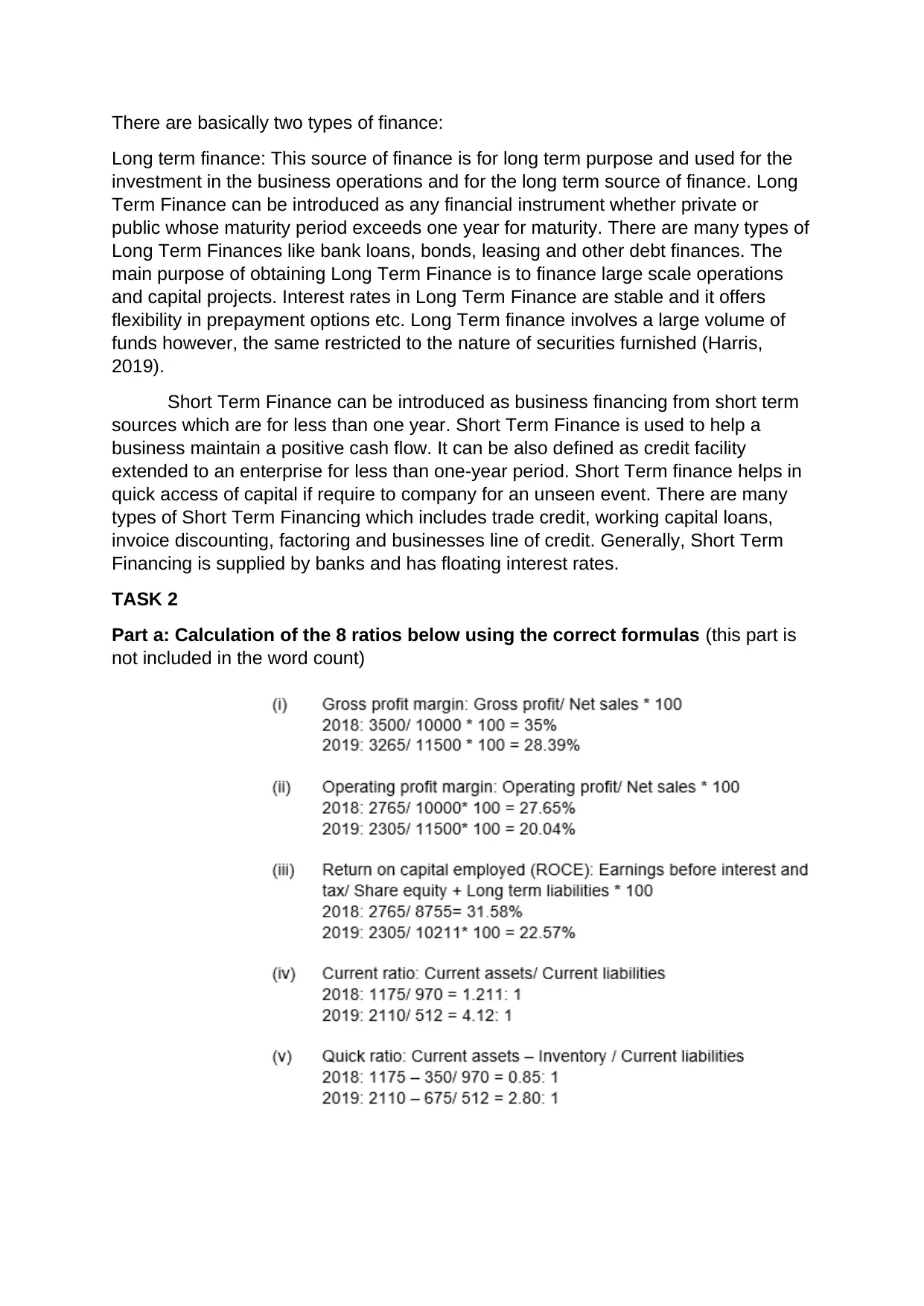
There are basically two types of finance:
Long term finance: This source of finance is for long term purpose and used for the
investment in the business operations and for the long term source of finance. Long
Term Finance can be introduced as any financial instrument whether private or
public whose maturity period exceeds one year for maturity. There are many types of
Long Term Finances like bank loans, bonds, leasing and other debt finances. The
main purpose of obtaining Long Term Finance is to finance large scale operations
and capital projects. Interest rates in Long Term Finance are stable and it offers
flexibility in prepayment options etc. Long Term finance involves a large volume of
funds however, the same restricted to the nature of securities furnished (Harris,
2019).
Short Term Finance can be introduced as business financing from short term
sources which are for less than one year. Short Term Finance is used to help a
business maintain a positive cash flow. It can be also defined as credit facility
extended to an enterprise for less than one-year period. Short Term finance helps in
quick access of capital if require to company for an unseen event. There are many
types of Short Term Financing which includes trade credit, working capital loans,
invoice discounting, factoring and businesses line of credit. Generally, Short Term
Financing is supplied by banks and has floating interest rates.
TASK 2
Part a: Calculation of the 8 ratios below using the correct formulas (this part is
not included in the word count)
Long term finance: This source of finance is for long term purpose and used for the
investment in the business operations and for the long term source of finance. Long
Term Finance can be introduced as any financial instrument whether private or
public whose maturity period exceeds one year for maturity. There are many types of
Long Term Finances like bank loans, bonds, leasing and other debt finances. The
main purpose of obtaining Long Term Finance is to finance large scale operations
and capital projects. Interest rates in Long Term Finance are stable and it offers
flexibility in prepayment options etc. Long Term finance involves a large volume of
funds however, the same restricted to the nature of securities furnished (Harris,
2019).
Short Term Finance can be introduced as business financing from short term
sources which are for less than one year. Short Term Finance is used to help a
business maintain a positive cash flow. It can be also defined as credit facility
extended to an enterprise for less than one-year period. Short Term finance helps in
quick access of capital if require to company for an unseen event. There are many
types of Short Term Financing which includes trade credit, working capital loans,
invoice discounting, factoring and businesses line of credit. Generally, Short Term
Financing is supplied by banks and has floating interest rates.
TASK 2
Part a: Calculation of the 8 ratios below using the correct formulas (this part is
not included in the word count)
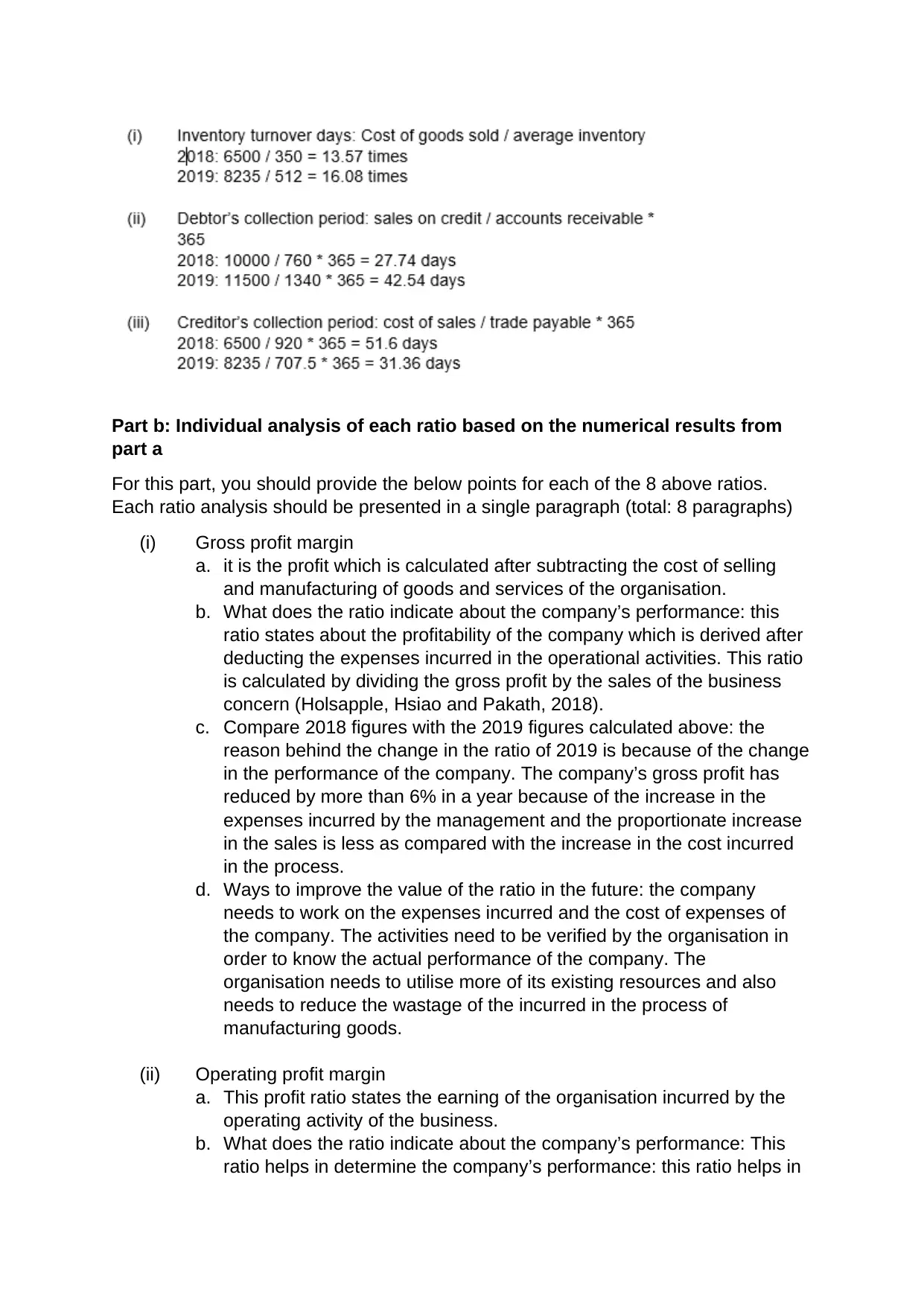
Part b: Individual analysis of each ratio based on the numerical results from
part a
For this part, you should provide the below points for each of the 8 above ratios.
Each ratio analysis should be presented in a single paragraph (total: 8 paragraphs)
(i) Gross profit margin
a. it is the profit which is calculated after subtracting the cost of selling
and manufacturing of goods and services of the organisation.
b. What does the ratio indicate about the company’s performance: this
ratio states about the profitability of the company which is derived after
deducting the expenses incurred in the operational activities. This ratio
is calculated by dividing the gross profit by the sales of the business
concern (Holsapple, Hsiao and Pakath, 2018).
c. Compare 2018 figures with the 2019 figures calculated above: the
reason behind the change in the ratio of 2019 is because of the change
in the performance of the company. The company’s gross profit has
reduced by more than 6% in a year because of the increase in the
expenses incurred by the management and the proportionate increase
in the sales is less as compared with the increase in the cost incurred
in the process.
d. Ways to improve the value of the ratio in the future: the company
needs to work on the expenses incurred and the cost of expenses of
the company. The activities need to be verified by the organisation in
order to know the actual performance of the company. The
organisation needs to utilise more of its existing resources and also
needs to reduce the wastage of the incurred in the process of
manufacturing goods.
(ii) Operating profit margin
a. This profit ratio states the earning of the organisation incurred by the
operating activity of the business.
b. What does the ratio indicate about the company’s performance: This
ratio helps in determine the company’s performance: this ratio helps in
part a
For this part, you should provide the below points for each of the 8 above ratios.
Each ratio analysis should be presented in a single paragraph (total: 8 paragraphs)
(i) Gross profit margin
a. it is the profit which is calculated after subtracting the cost of selling
and manufacturing of goods and services of the organisation.
b. What does the ratio indicate about the company’s performance: this
ratio states about the profitability of the company which is derived after
deducting the expenses incurred in the operational activities. This ratio
is calculated by dividing the gross profit by the sales of the business
concern (Holsapple, Hsiao and Pakath, 2018).
c. Compare 2018 figures with the 2019 figures calculated above: the
reason behind the change in the ratio of 2019 is because of the change
in the performance of the company. The company’s gross profit has
reduced by more than 6% in a year because of the increase in the
expenses incurred by the management and the proportionate increase
in the sales is less as compared with the increase in the cost incurred
in the process.
d. Ways to improve the value of the ratio in the future: the company
needs to work on the expenses incurred and the cost of expenses of
the company. The activities need to be verified by the organisation in
order to know the actual performance of the company. The
organisation needs to utilise more of its existing resources and also
needs to reduce the wastage of the incurred in the process of
manufacturing goods.
(ii) Operating profit margin
a. This profit ratio states the earning of the organisation incurred by the
operating activity of the business.
b. What does the ratio indicate about the company’s performance: This
ratio helps in determine the company’s performance: this ratio helps in
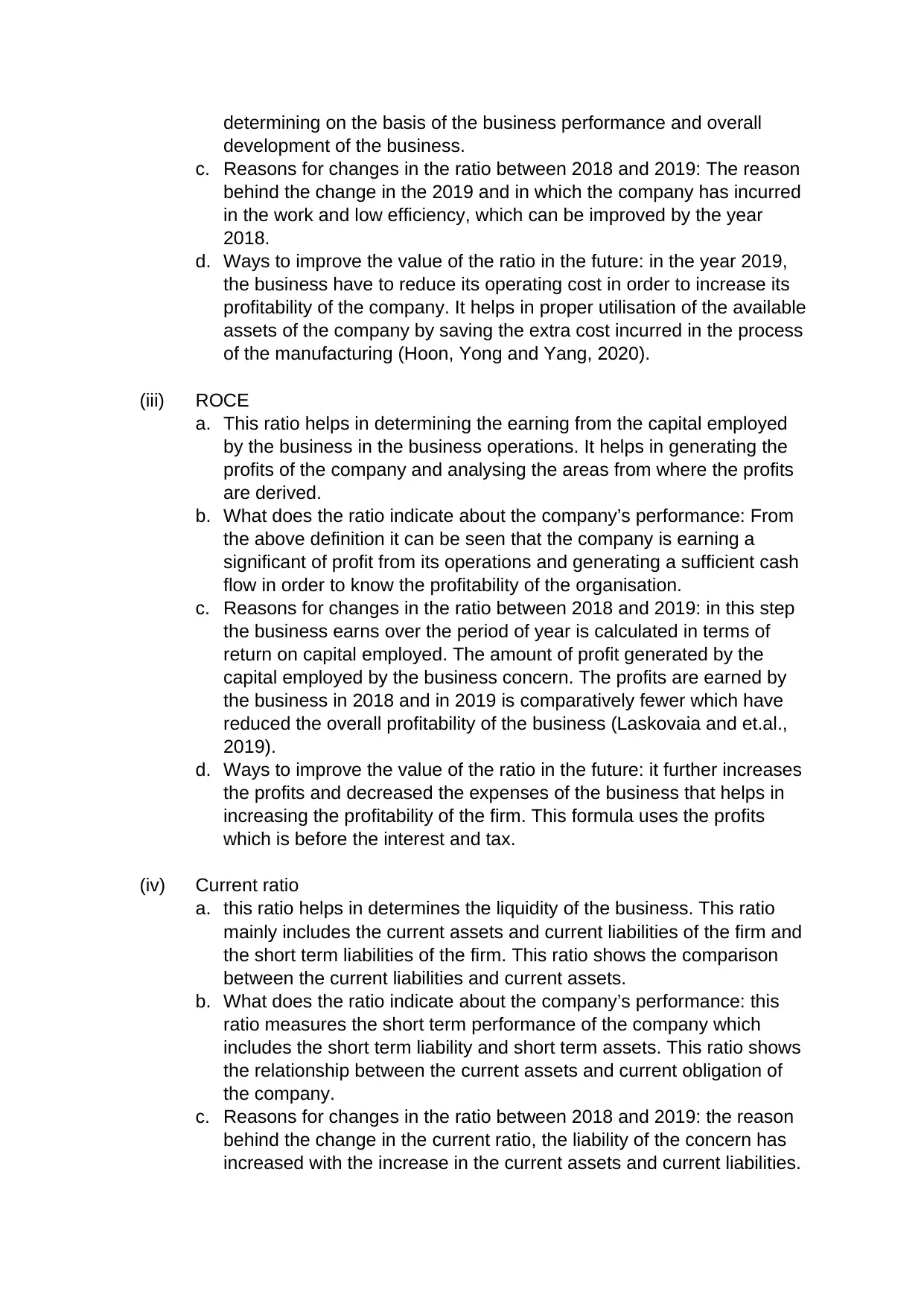
determining on the basis of the business performance and overall
development of the business.
c. Reasons for changes in the ratio between 2018 and 2019: The reason
behind the change in the 2019 and in which the company has incurred
in the work and low efficiency, which can be improved by the year
2018.
d. Ways to improve the value of the ratio in the future: in the year 2019,
the business have to reduce its operating cost in order to increase its
profitability of the company. It helps in proper utilisation of the available
assets of the company by saving the extra cost incurred in the process
of the manufacturing (Hoon, Yong and Yang, 2020).
(iii) ROCE
a. This ratio helps in determining the earning from the capital employed
by the business in the business operations. It helps in generating the
profits of the company and analysing the areas from where the profits
are derived.
b. What does the ratio indicate about the company’s performance: From
the above definition it can be seen that the company is earning a
significant of profit from its operations and generating a sufficient cash
flow in order to know the profitability of the organisation.
c. Reasons for changes in the ratio between 2018 and 2019: in this step
the business earns over the period of year is calculated in terms of
return on capital employed. The amount of profit generated by the
capital employed by the business concern. The profits are earned by
the business in 2018 and in 2019 is comparatively fewer which have
reduced the overall profitability of the business (Laskovaia and et.al.,
2019).
d. Ways to improve the value of the ratio in the future: it further increases
the profits and decreased the expenses of the business that helps in
increasing the profitability of the firm. This formula uses the profits
which is before the interest and tax.
(iv) Current ratio
a. this ratio helps in determines the liquidity of the business. This ratio
mainly includes the current assets and current liabilities of the firm and
the short term liabilities of the firm. This ratio shows the comparison
between the current liabilities and current assets.
b. What does the ratio indicate about the company’s performance: this
ratio measures the short term performance of the company which
includes the short term liability and short term assets. This ratio shows
the relationship between the current assets and current obligation of
the company.
c. Reasons for changes in the ratio between 2018 and 2019: the reason
behind the change in the current ratio, the liability of the concern has
increased with the increase in the current assets and current liabilities.
development of the business.
c. Reasons for changes in the ratio between 2018 and 2019: The reason
behind the change in the 2019 and in which the company has incurred
in the work and low efficiency, which can be improved by the year
2018.
d. Ways to improve the value of the ratio in the future: in the year 2019,
the business have to reduce its operating cost in order to increase its
profitability of the company. It helps in proper utilisation of the available
assets of the company by saving the extra cost incurred in the process
of the manufacturing (Hoon, Yong and Yang, 2020).
(iii) ROCE
a. This ratio helps in determining the earning from the capital employed
by the business in the business operations. It helps in generating the
profits of the company and analysing the areas from where the profits
are derived.
b. What does the ratio indicate about the company’s performance: From
the above definition it can be seen that the company is earning a
significant of profit from its operations and generating a sufficient cash
flow in order to know the profitability of the organisation.
c. Reasons for changes in the ratio between 2018 and 2019: in this step
the business earns over the period of year is calculated in terms of
return on capital employed. The amount of profit generated by the
capital employed by the business concern. The profits are earned by
the business in 2018 and in 2019 is comparatively fewer which have
reduced the overall profitability of the business (Laskovaia and et.al.,
2019).
d. Ways to improve the value of the ratio in the future: it further increases
the profits and decreased the expenses of the business that helps in
increasing the profitability of the firm. This formula uses the profits
which is before the interest and tax.
(iv) Current ratio
a. this ratio helps in determines the liquidity of the business. This ratio
mainly includes the current assets and current liabilities of the firm and
the short term liabilities of the firm. This ratio shows the comparison
between the current liabilities and current assets.
b. What does the ratio indicate about the company’s performance: this
ratio measures the short term performance of the company which
includes the short term liability and short term assets. This ratio shows
the relationship between the current assets and current obligation of
the company.
c. Reasons for changes in the ratio between 2018 and 2019: the reason
behind the change in the current ratio, the liability of the concern has
increased with the increase in the current assets and current liabilities.
Paraphrase This Document
Need a fresh take? Get an instant paraphrase of this document with our AI Paraphraser
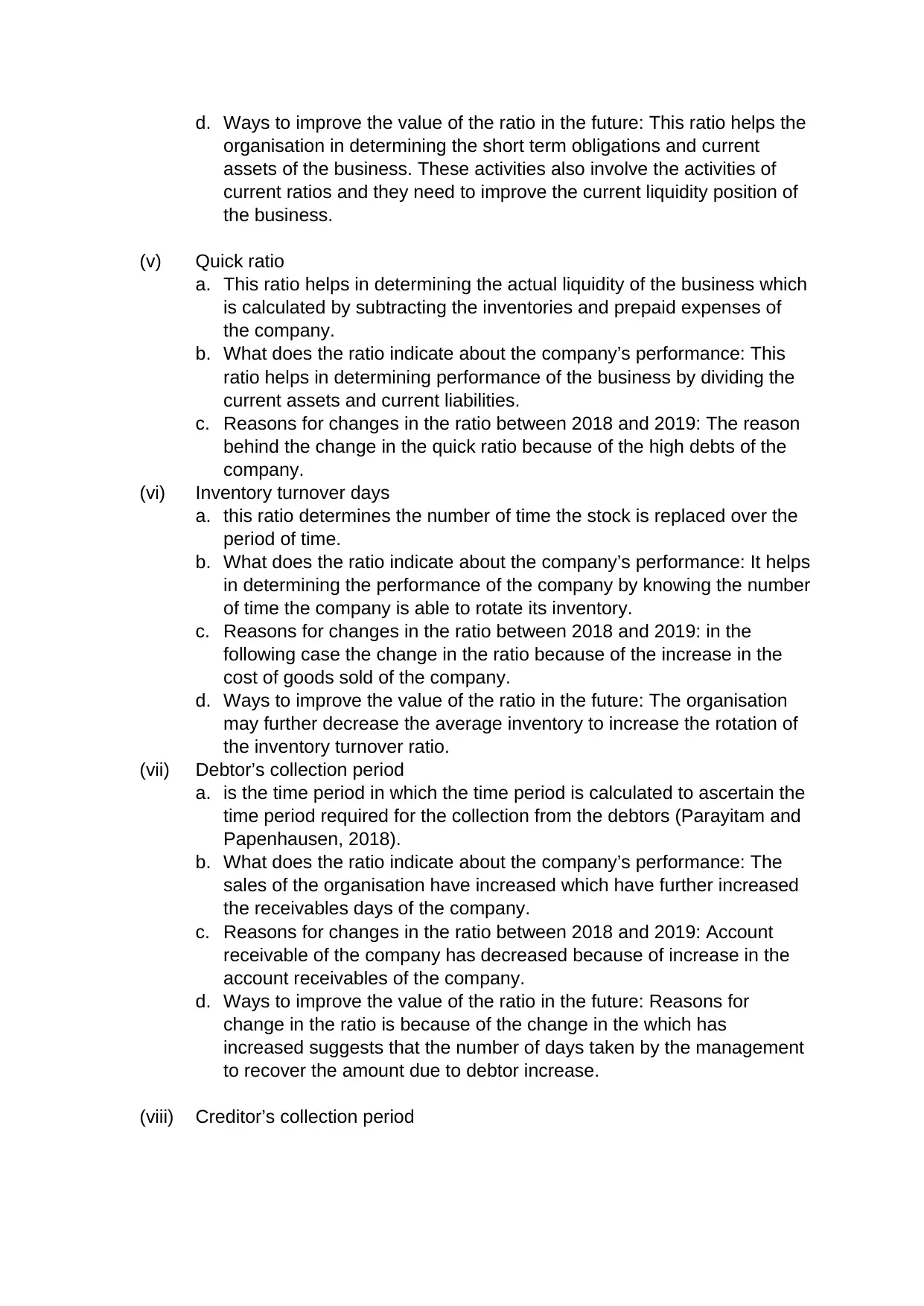
d. Ways to improve the value of the ratio in the future: This ratio helps the
organisation in determining the short term obligations and current
assets of the business. These activities also involve the activities of
current ratios and they need to improve the current liquidity position of
the business.
(v) Quick ratio
a. This ratio helps in determining the actual liquidity of the business which
is calculated by subtracting the inventories and prepaid expenses of
the company.
b. What does the ratio indicate about the company’s performance: This
ratio helps in determining performance of the business by dividing the
current assets and current liabilities.
c. Reasons for changes in the ratio between 2018 and 2019: The reason
behind the change in the quick ratio because of the high debts of the
company.
(vi) Inventory turnover days
a. this ratio determines the number of time the stock is replaced over the
period of time.
b. What does the ratio indicate about the company’s performance: It helps
in determining the performance of the company by knowing the number
of time the company is able to rotate its inventory.
c. Reasons for changes in the ratio between 2018 and 2019: in the
following case the change in the ratio because of the increase in the
cost of goods sold of the company.
d. Ways to improve the value of the ratio in the future: The organisation
may further decrease the average inventory to increase the rotation of
the inventory turnover ratio.
(vii) Debtor’s collection period
a. is the time period in which the time period is calculated to ascertain the
time period required for the collection from the debtors (Parayitam and
Papenhausen, 2018).
b. What does the ratio indicate about the company’s performance: The
sales of the organisation have increased which have further increased
the receivables days of the company.
c. Reasons for changes in the ratio between 2018 and 2019: Account
receivable of the company has decreased because of increase in the
account receivables of the company.
d. Ways to improve the value of the ratio in the future: Reasons for
change in the ratio is because of the change in the which has
increased suggests that the number of days taken by the management
to recover the amount due to debtor increase.
(viii) Creditor’s collection period
organisation in determining the short term obligations and current
assets of the business. These activities also involve the activities of
current ratios and they need to improve the current liquidity position of
the business.
(v) Quick ratio
a. This ratio helps in determining the actual liquidity of the business which
is calculated by subtracting the inventories and prepaid expenses of
the company.
b. What does the ratio indicate about the company’s performance: This
ratio helps in determining performance of the business by dividing the
current assets and current liabilities.
c. Reasons for changes in the ratio between 2018 and 2019: The reason
behind the change in the quick ratio because of the high debts of the
company.
(vi) Inventory turnover days
a. this ratio determines the number of time the stock is replaced over the
period of time.
b. What does the ratio indicate about the company’s performance: It helps
in determining the performance of the company by knowing the number
of time the company is able to rotate its inventory.
c. Reasons for changes in the ratio between 2018 and 2019: in the
following case the change in the ratio because of the increase in the
cost of goods sold of the company.
d. Ways to improve the value of the ratio in the future: The organisation
may further decrease the average inventory to increase the rotation of
the inventory turnover ratio.
(vii) Debtor’s collection period
a. is the time period in which the time period is calculated to ascertain the
time period required for the collection from the debtors (Parayitam and
Papenhausen, 2018).
b. What does the ratio indicate about the company’s performance: The
sales of the organisation have increased which have further increased
the receivables days of the company.
c. Reasons for changes in the ratio between 2018 and 2019: Account
receivable of the company has decreased because of increase in the
account receivables of the company.
d. Ways to improve the value of the ratio in the future: Reasons for
change in the ratio is because of the change in the which has
increased suggests that the number of days taken by the management
to recover the amount due to debtor increase.
(viii) Creditor’s collection period
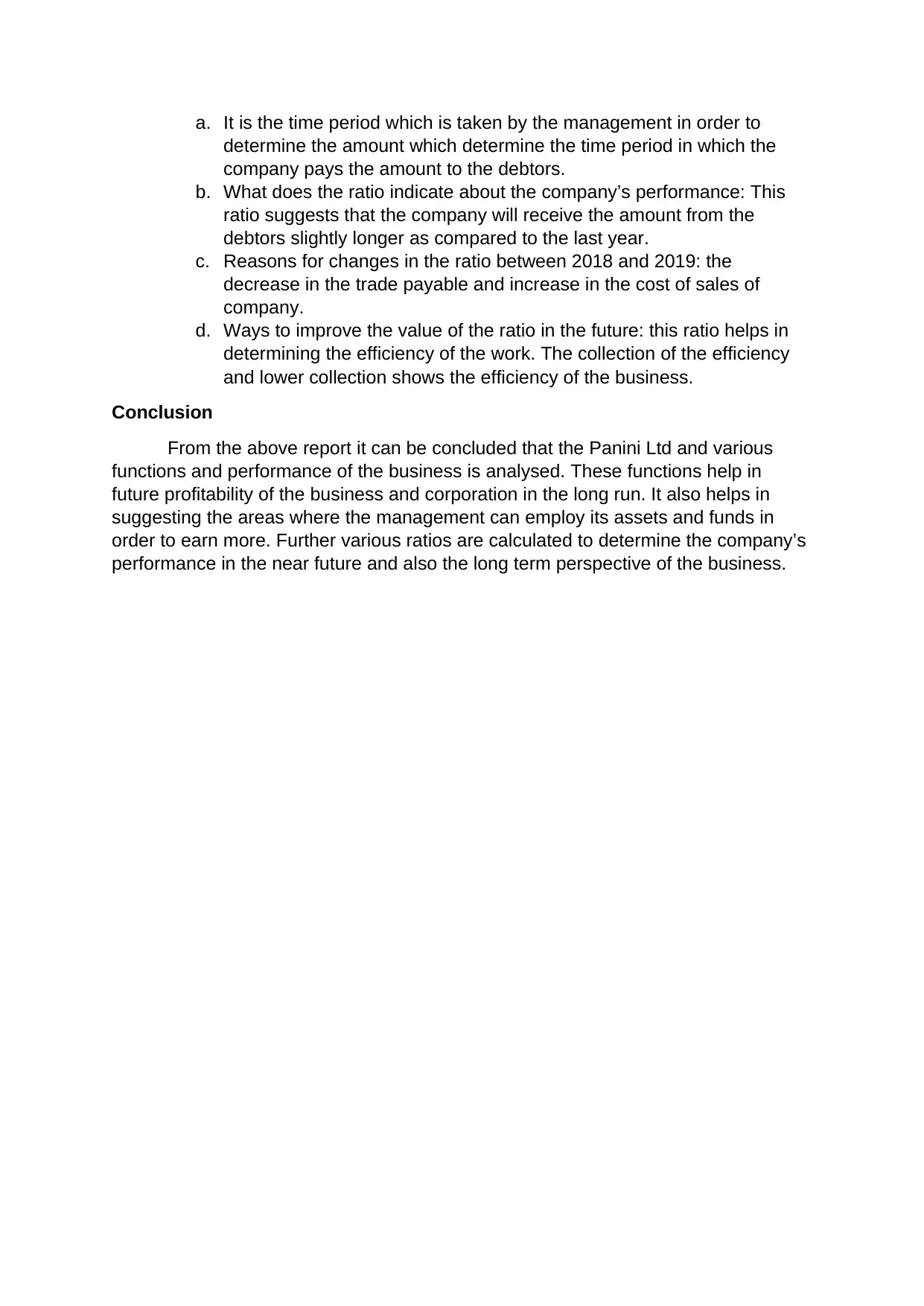
a. It is the time period which is taken by the management in order to
determine the amount which determine the time period in which the
company pays the amount to the debtors.
b. What does the ratio indicate about the company’s performance: This
ratio suggests that the company will receive the amount from the
debtors slightly longer as compared to the last year.
c. Reasons for changes in the ratio between 2018 and 2019: the
decrease in the trade payable and increase in the cost of sales of
company.
d. Ways to improve the value of the ratio in the future: this ratio helps in
determining the efficiency of the work. The collection of the efficiency
and lower collection shows the efficiency of the business.
Conclusion
From the above report it can be concluded that the Panini Ltd and various
functions and performance of the business is analysed. These functions help in
future profitability of the business and corporation in the long run. It also helps in
suggesting the areas where the management can employ its assets and funds in
order to earn more. Further various ratios are calculated to determine the company’s
performance in the near future and also the long term perspective of the business.
determine the amount which determine the time period in which the
company pays the amount to the debtors.
b. What does the ratio indicate about the company’s performance: This
ratio suggests that the company will receive the amount from the
debtors slightly longer as compared to the last year.
c. Reasons for changes in the ratio between 2018 and 2019: the
decrease in the trade payable and increase in the cost of sales of
company.
d. Ways to improve the value of the ratio in the future: this ratio helps in
determining the efficiency of the work. The collection of the efficiency
and lower collection shows the efficiency of the business.
Conclusion
From the above report it can be concluded that the Panini Ltd and various
functions and performance of the business is analysed. These functions help in
future profitability of the business and corporation in the long run. It also helps in
suggesting the areas where the management can employ its assets and funds in
order to earn more. Further various ratios are calculated to determine the company’s
performance in the near future and also the long term perspective of the business.
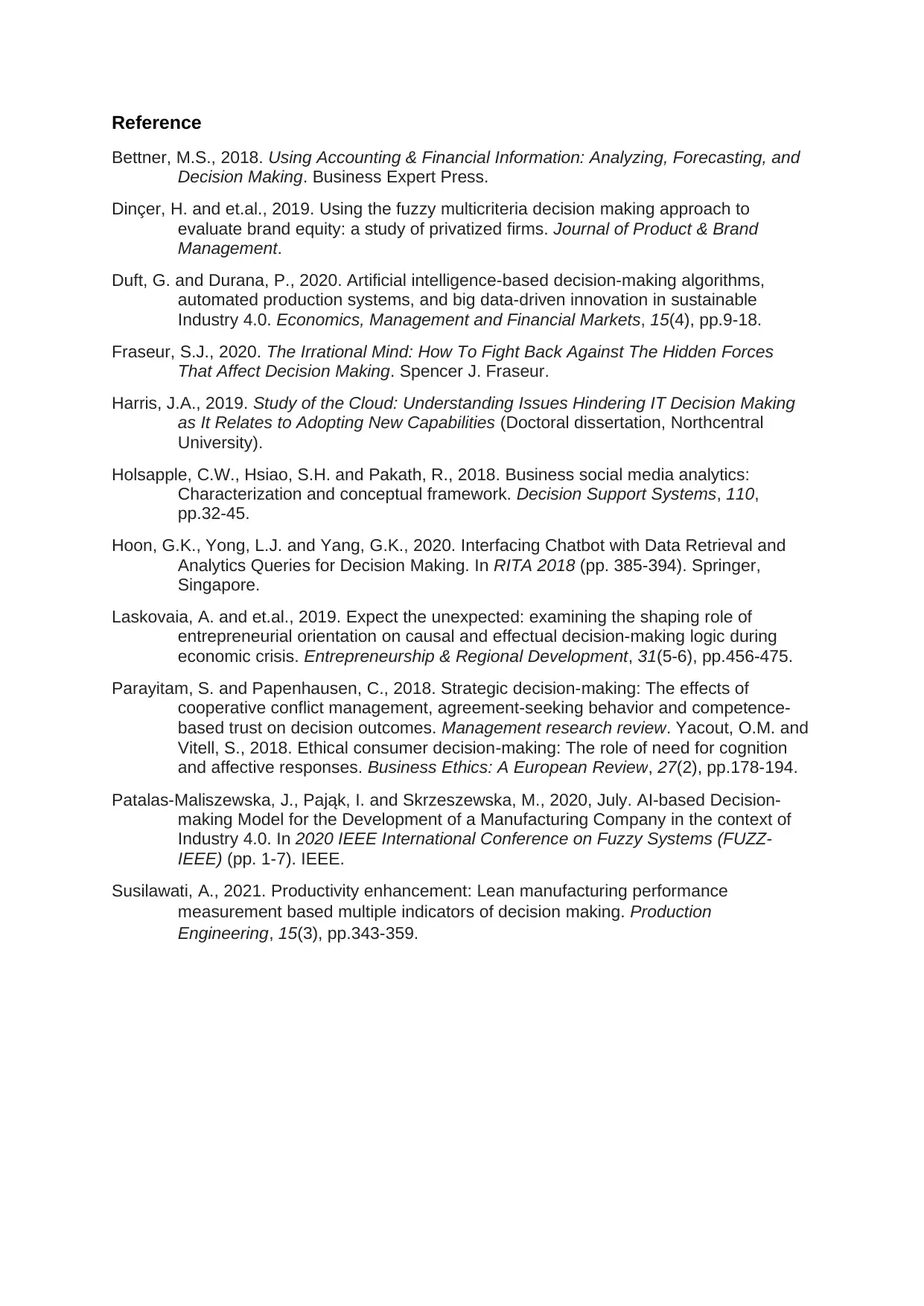
Reference
Bettner, M.S., 2018. Using Accounting & Financial Information: Analyzing, Forecasting, and
Decision Making. Business Expert Press.
Dinçer, H. and et.al., 2019. Using the fuzzy multicriteria decision making approach to
evaluate brand equity: a study of privatized firms. Journal of Product & Brand
Management.
Duft, G. and Durana, P., 2020. Artificial intelligence-based decision-making algorithms,
automated production systems, and big data-driven innovation in sustainable
Industry 4.0. Economics, Management and Financial Markets, 15(4), pp.9-18.
Fraseur, S.J., 2020. The Irrational Mind: How To Fight Back Against The Hidden Forces
That Affect Decision Making. Spencer J. Fraseur.
Harris, J.A., 2019. Study of the Cloud: Understanding Issues Hindering IT Decision Making
as It Relates to Adopting New Capabilities (Doctoral dissertation, Northcentral
University).
Holsapple, C.W., Hsiao, S.H. and Pakath, R., 2018. Business social media analytics:
Characterization and conceptual framework. Decision Support Systems, 110,
pp.32-45.
Hoon, G.K., Yong, L.J. and Yang, G.K., 2020. Interfacing Chatbot with Data Retrieval and
Analytics Queries for Decision Making. In RITA 2018 (pp. 385-394). Springer,
Singapore.
Laskovaia, A. and et.al., 2019. Expect the unexpected: examining the shaping role of
entrepreneurial orientation on causal and effectual decision-making logic during
economic crisis. Entrepreneurship & Regional Development, 31(5-6), pp.456-475.
Parayitam, S. and Papenhausen, C., 2018. Strategic decision-making: The effects of
cooperative conflict management, agreement-seeking behavior and competence-
based trust on decision outcomes. Management research review. Yacout, O.M. and
Vitell, S., 2018. Ethical consumer decision‐making: The role of need for cognition
and affective responses. Business Ethics: A European Review, 27(2), pp.178-194.
Patalas-Maliszewska, J., Pająk, I. and Skrzeszewska, M., 2020, July. AI-based Decision-
making Model for the Development of a Manufacturing Company in the context of
Industry 4.0. In 2020 IEEE International Conference on Fuzzy Systems (FUZZ-
IEEE) (pp. 1-7). IEEE.
Susilawati, A., 2021. Productivity enhancement: Lean manufacturing performance
measurement based multiple indicators of decision making. Production
Engineering, 15(3), pp.343-359.
Bettner, M.S., 2018. Using Accounting & Financial Information: Analyzing, Forecasting, and
Decision Making. Business Expert Press.
Dinçer, H. and et.al., 2019. Using the fuzzy multicriteria decision making approach to
evaluate brand equity: a study of privatized firms. Journal of Product & Brand
Management.
Duft, G. and Durana, P., 2020. Artificial intelligence-based decision-making algorithms,
automated production systems, and big data-driven innovation in sustainable
Industry 4.0. Economics, Management and Financial Markets, 15(4), pp.9-18.
Fraseur, S.J., 2020. The Irrational Mind: How To Fight Back Against The Hidden Forces
That Affect Decision Making. Spencer J. Fraseur.
Harris, J.A., 2019. Study of the Cloud: Understanding Issues Hindering IT Decision Making
as It Relates to Adopting New Capabilities (Doctoral dissertation, Northcentral
University).
Holsapple, C.W., Hsiao, S.H. and Pakath, R., 2018. Business social media analytics:
Characterization and conceptual framework. Decision Support Systems, 110,
pp.32-45.
Hoon, G.K., Yong, L.J. and Yang, G.K., 2020. Interfacing Chatbot with Data Retrieval and
Analytics Queries for Decision Making. In RITA 2018 (pp. 385-394). Springer,
Singapore.
Laskovaia, A. and et.al., 2019. Expect the unexpected: examining the shaping role of
entrepreneurial orientation on causal and effectual decision-making logic during
economic crisis. Entrepreneurship & Regional Development, 31(5-6), pp.456-475.
Parayitam, S. and Papenhausen, C., 2018. Strategic decision-making: The effects of
cooperative conflict management, agreement-seeking behavior and competence-
based trust on decision outcomes. Management research review. Yacout, O.M. and
Vitell, S., 2018. Ethical consumer decision‐making: The role of need for cognition
and affective responses. Business Ethics: A European Review, 27(2), pp.178-194.
Patalas-Maliszewska, J., Pająk, I. and Skrzeszewska, M., 2020, July. AI-based Decision-
making Model for the Development of a Manufacturing Company in the context of
Industry 4.0. In 2020 IEEE International Conference on Fuzzy Systems (FUZZ-
IEEE) (pp. 1-7). IEEE.
Susilawati, A., 2021. Productivity enhancement: Lean manufacturing performance
measurement based multiple indicators of decision making. Production
Engineering, 15(3), pp.343-359.
1 out of 10
Related Documents
Your All-in-One AI-Powered Toolkit for Academic Success.
+13062052269
info@desklib.com
Available 24*7 on WhatsApp / Email
![[object Object]](/_next/static/media/star-bottom.7253800d.svg)
Unlock your academic potential
© 2024 | Zucol Services PVT LTD | All rights reserved.

